The Iran-Israel conflict and equity markets are now in sharp focus. As direct strikes escalated in June 2025, global financial markets responded immediately. Israel’s airstrikes on Iranian nuclear and energy infrastructure triggered retaliatory missile and drone attacks from Iran.
The dropped nearly 2%, the lost over 1%, and surged by more than 10% in a matter of days. and the rallied as investors moved into safe-haven assets.
With a holiday-shortened week ahead, the market will likely remain volatile as traders focus on real-time developments between the two countries. {{art-200662194||As discussed last week}}, the markets have had a stellar run from the “Liberation Day” lows and were overbought going into the news. To wit:
“The market remains overbought short-term, but it is not uncommon for markets to stay overbought longer than most expect. While we patiently await a pullback to increase portfolio exposure, that could be a while longer before it occurs.
Critically, we are not looking for LOWER prices to add exposure. I am okay with paying higher prices. However, we are searching for a better risk/reward opportunity to add exposure. As such, a consolidation period that allows relative strength or momentum to cool off somewhat will provide a better buying opportunity than under current conditions. We already have sufficient exposure to the market to gain performance when markets rise, but deploying capital at these levels is more ‘risky’ than I prefer.
However, the patience of “waiting” is the hard part.
As we asked then,
“Why will the market pull back? There are many reasons, including the ongoing supply/demand imbalance, the reduction of corporate share buybacks, and the continuing risk from tariff negotiations.”
However, the Iran-Israel conflict was not on our “bingo” card. What is crucial for investors to understand is that when markets are driven by bullish momentum, a catalyst is required to bring sellers into the market. Such is why “”
“In the current bull market, few people are willing to sell, so buyers must keep bidding up prices to attract a seller to make a transaction. As long as this remains the case and exuberance exceeds logic, buyers will continue to pay higher prices to get into the positions they want to own. Such is the very definition of the “greater fool” theory.
However, at some point, for whatever reason, this dynamic will change. Buyers will become more scarce as they refuse to pay a higher price. When sellers realize the change, they will rush to sell to a diminishing pool of buyers.”
Did we see the early stages of that shift between buyers and sellers on Friday? Maybe. We will find out this week.
However, regardless of what happens over the next few days, the Iran-Israel conflict will likely have a short-lived impact on the financial markets. For investors, it is essential to review past events and identify where opportunities developed to deploy capital at better prices.
A Brief History Of Previous Conflicts
While muted, the initial reaction to the start of the Iran-Israel conflict on Friday followed a familiar pattern in market behavior during geopolitical shocks:
- A rapid repricing of risk,
- A shift into defensive sectors,
- And an eventual stabilization as policymakers and investors recalibrate expectations.
The response to this conflict, in both direction and magnitude, mirrors those from previous regional military crises in the Middle East.
For example, during the Yom Kippur War in 1973, the Arab-Israeli conflict triggered an oil embargo that quadrupled crude prices and led to prolonged equity market declines. Energy stocks and inflation-linked assets outperformed while broader equities slumped. The 1979 Iranian Revolution and subsequent Iran-Iraq War again caused oil prices to double, with global equities suffering initially before recovering as new energy trade flows emerged.
More recent conflicts—such as the Gulf War, the 2006 Israel-Hezbollah conflict, and the 2014 Gaza War produced short-lived equity corrections. In each instance, safe-haven assets surged early on, but most global indices rebounded once the duration and geographic scope of the conflict became clearer. What is most crucial for investors to understand is that markets tend to price in geopolitical risk swiftly, primarily when energy supply chains or critical infrastructure are targeted.
While geopolitical events like the latest Iran-Israel conflict happen, investors focus on the worst possible outcomes. However, it is critical to step back and look at how markets have responded throughout history to such events. Carson Research published the following table on Friday, showing previous historical events and market outcomes.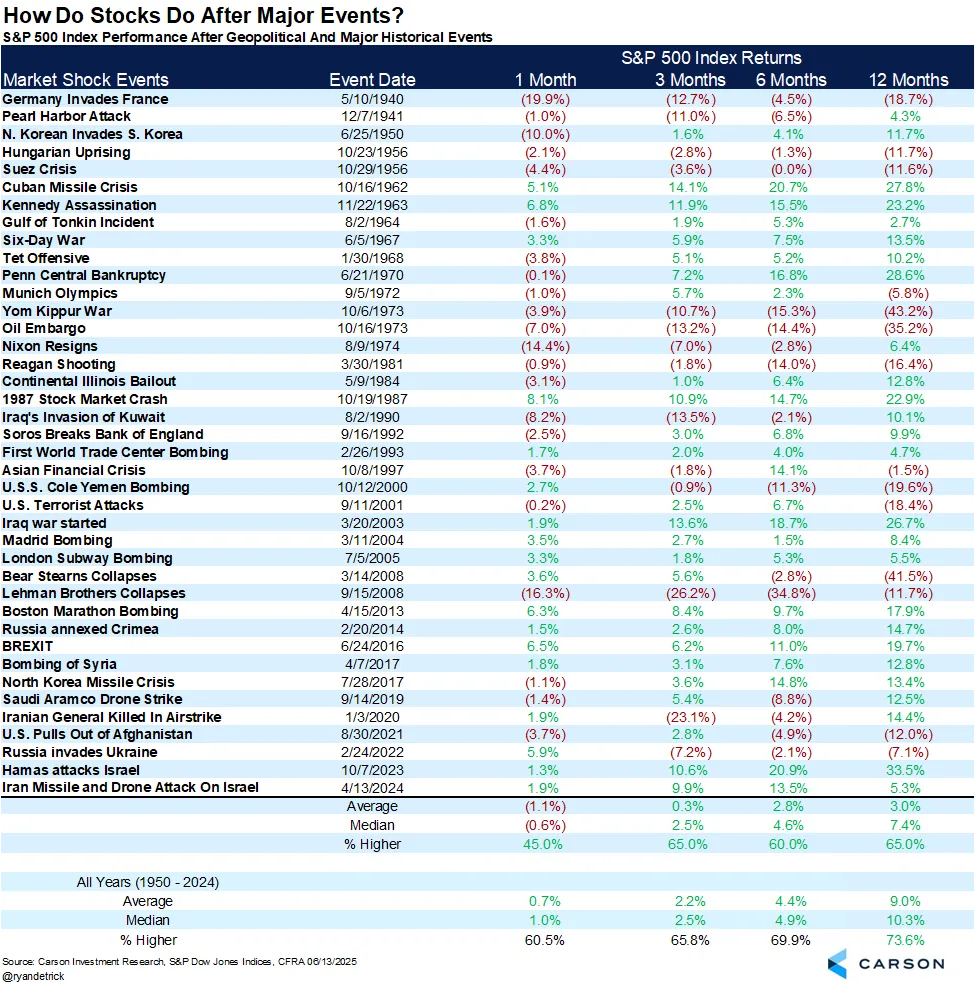
Yes, there were a few periods that led to more disastrous outcomes, such as the Yom Kippur War, the oil embargo, the USS Cole bombing, 9/11, and the London Subway bombing. However, those events coincided with the bursting of the “Nifty-50” bubble, the “Dot.com” bubble, and the “Financial Crisis.”
While there is undoubtedly a risk that the current Iran-Israel conflict could spiral into something larger, history suggests those odds are relatively low and that over the next 12 months, any near-term impact will likely produce investment opportunities.
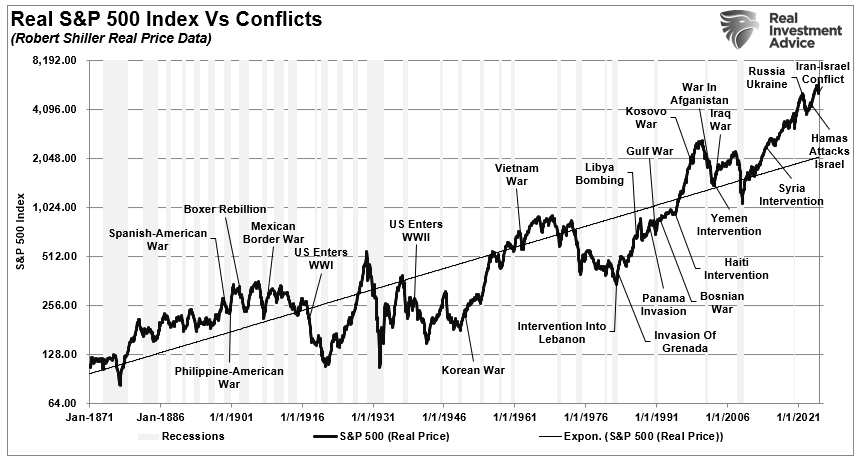
What is critical for investors is that while the near-term outlook will likely be defined by uncertainty and elevated volatility, the Iran-Israel conflict should likely not be extrapolated into the expectation of a major mean-reverting event. As we discussed in “
“Investing means cutting through noise, avoiding speculation, and relying on data. For example, the media is jammed with emotionally charged headlines about tariff-induced trade wars, recessions, and de-dollarization. In reality, those events rarely occur.
The chart below is a normally distributed “bell curve” of potential events and outcomes. In simple terms, 68.26% of the time, typical outcomes occur. Economically speaking, such would be a normal recession or the avoidance of a recession. 95.44% of the time, we are most likely dealing with a range of outcomes between a reasonably deep recession and standard economic growth rates. However, there is a 2.14% chance that we could see another economic crisis like the 2008 Financial Crisis. But what about “economic armageddon?” That event where nothing matters but “gold, beanie weenies, and bunker.” That is a 0.14% possibility.”
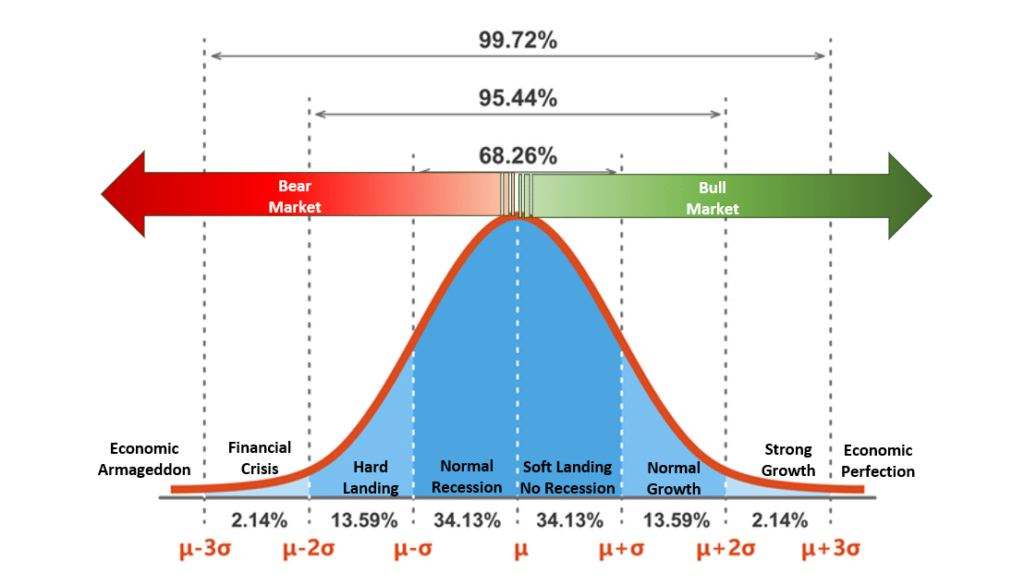
Investors must consider the most likely outcome for the overall market and which sectors could most likely benefit.
Which Sectors Will Likely Benefit From The Iran-Israel Conflict
This concept of possibilities versus possibilities is crucial to navigating investment outcomes. Rather than trying to guess what markets will do tomorrow, successful investors assess various outcomes and plan accordingly.
In other words, if your current expectation is that the Iran-Israel conflict will lead to an indefinite increase in market volatility, you will likely be disappointed. This is why we continually suggest managing risk, rebalancing, taking profits, and focusing on allocations. Building portfolios that account for downside risks, multiple economic scenarios, and margin of safety allows investors to remain calm when markets shift. The only thing investors need to fear is fear itself.
The reality is that emotional decisions typically underperform disciplined ones. Investors can’t eliminate volatility, but can control their reactions to it.
So, given the market’s current overbought condition, what is the most likely historical outcome of the Iran-Israel conflict?
- Equity markets will likely experience further stress if the conflict persists or spreads to neighboring regions.
- U.S. equities could decline another 3% to 5% if oil prices sustain a move toward $80 to $90 per barrel.
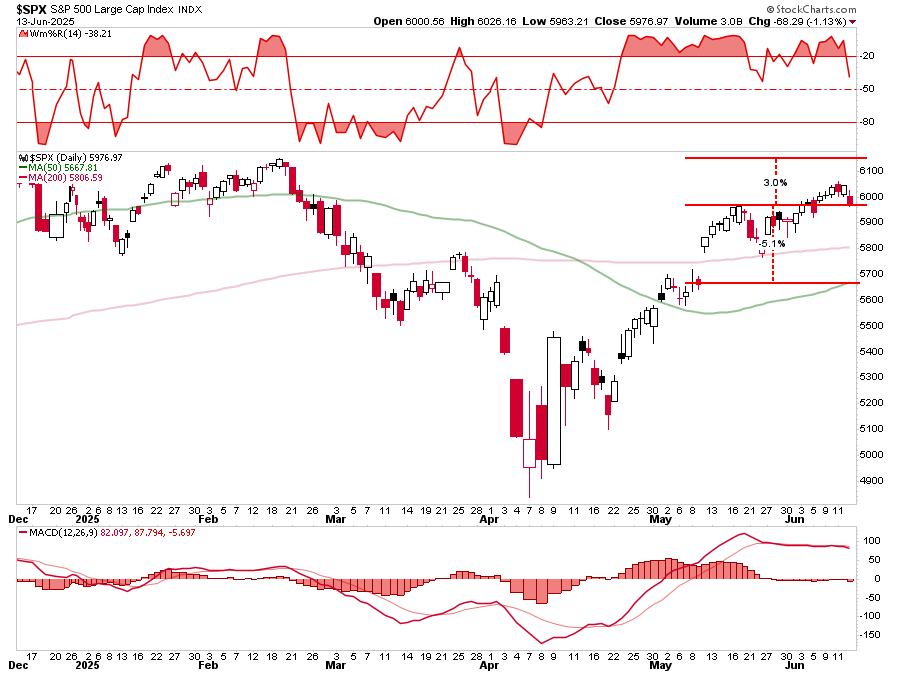
As shown, a 5% decline would likely find support at the 50-DMA.
However, even if the overall market declines due to geopolitical and commodity price stress, there will be opportunities within the underlying market sectors.
- – Strong near-term outlook. Higher oil/gas benefits major producers, pipeline operators, and energy service companies.
- Defense & aerospace – Increased military spending will boost prime U.S. contractors, cybersecurity firms, and intelligence service providers.
- & infrastructure – Governments may increase spending post‑conflict. Utility operators and infrastructure rebuilding firms could benefit.
- Safe-haven assets – Bonds, especially U.S. Treasuries, and precious metals offer defensive value during crises.
- Cyclical sectors to remain under pressure – Travel, leisure, consumer discretionary, and airlines face continued headwinds.
- & – Though volatile, core tech firms with strong fundamentals may hold up if global supply chains remain intact.
Notably, while sectors like energy will outperform during the conflict, investors must remain vigilant to reverse those trades when the dispute is resolved or signs of economic stress emerge. As shown, oil prices tend to fall sharply during periods of financial stress.
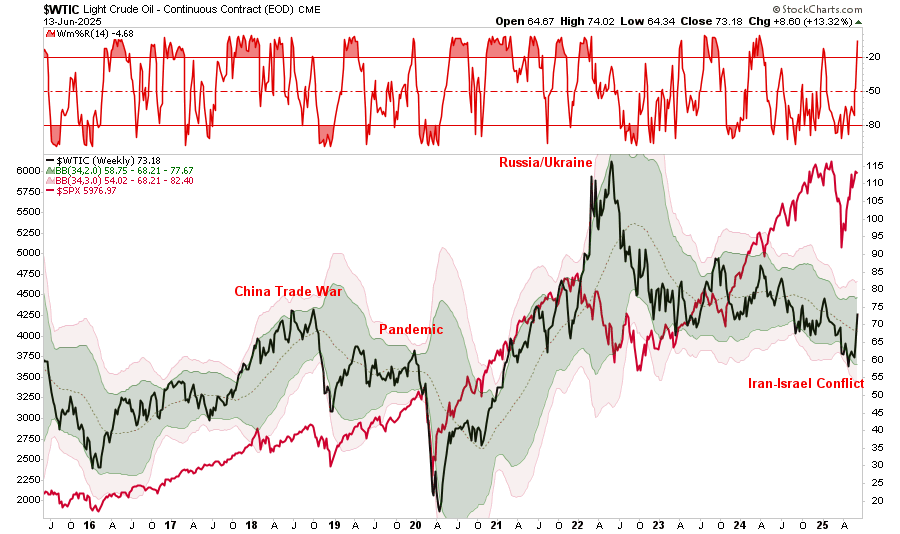
Conclusion & Things To Watch
Higher energy prices may undermine central banks’ plans to cut interest rates in the medium term. After four months of falling inflation, Wall Street expectations are falling, but higher oil prices rapidly impact reading, given the input of energy on consumer products.
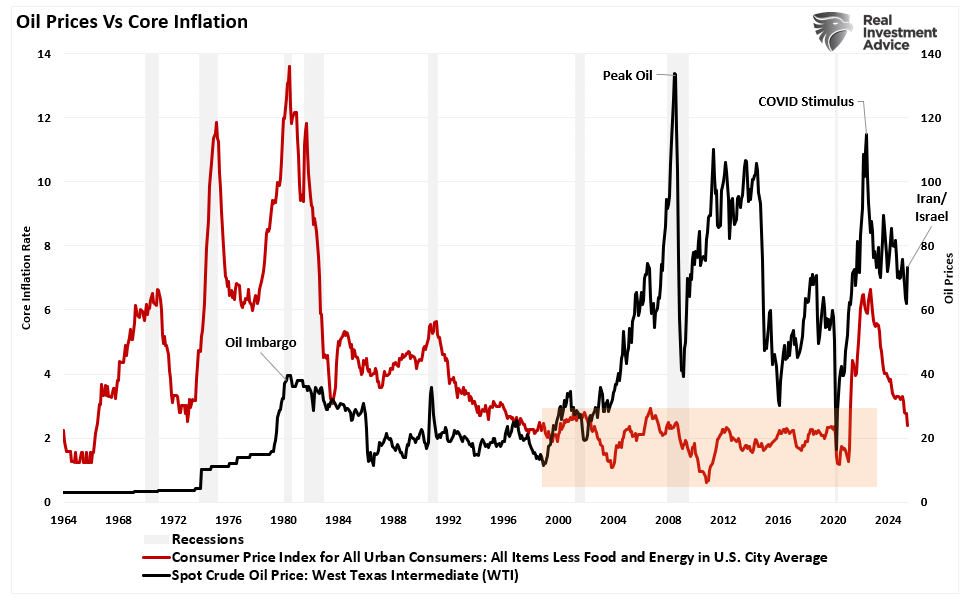
The Federal Reserve has already signaled caution. Therefore, if oil-driven inflation persists, may be delayed until late Q4 or early 2026. Further rate-cut delays could keep markets more volatile as investors recalibrate future earnings expectations amid slower consumer spending.
However, while short-term volatility is likely, in the long term, equity markets have historically recovered once tensions ease. If diplomatic efforts succeed in brokering a ceasefire or if both sides de-escalate military activity, global indices could rebound quickly. The key variables to watch will be:
- Oil prices,
- The pace of central bank policy adjustments, and
- The broader economic backdrop.
Back to the importance of risk management, some sectors will benefit from conflict escalation. Those same sectors will also decline sharply as the conflict winds down. Therefore, investors should take profits in those areas and rotate to companies involved in reconstruction and regional infrastructure development and reconstruction.
Peace agreements often unlock funding for rebuilding utilities, roads, power grids, and telecom systems. Firms in the industrial and materials sectors stand to gain from this transition.
The Iran-Israel conflict follows a pattern investors have previously seen: an initial shock, defensive sector outperformance, and eventual recovery. While the conflict introduces more serious geopolitical risk, history suggests such escalations quickly fade.
The most critical aspect for investors is not to extrapolate the current conflict into a tail-risk event. We know that reacting emotionally to short-term moves often destroys long-term returns.
